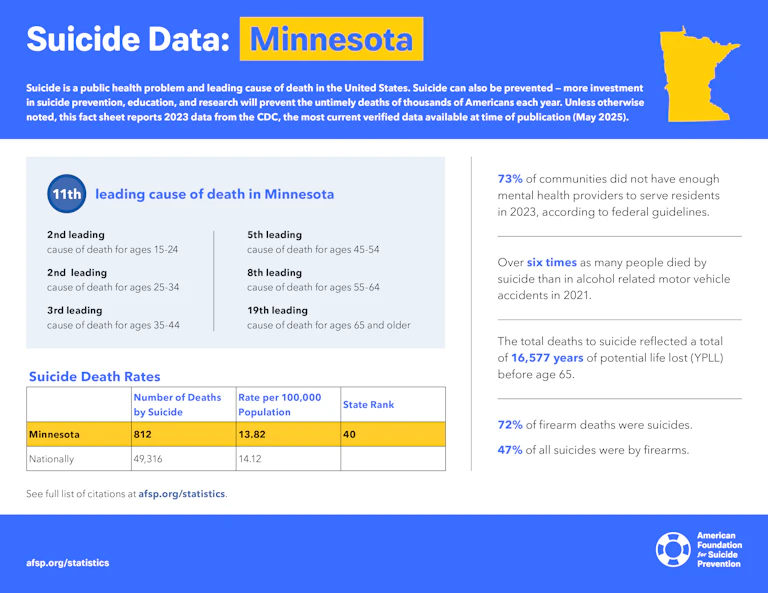Minnesota

Minnesota suicide prevention plans and initiatives
Minnesota’s Suicide Prevention Program (SPP) is housed within the Minnesota Department of Health (MDH) Injury and Violence Prevention Section. The Minnesota Suicide Prevention Planning Taskforce, a public-private partnership co-chaired by MDH and Suicide Awareness Voices of Education (SAVE), released the Minnesota State Suicide Prevention Plan 2023-2027 on February 2nd 2023 following the 2022 Suicide Prevention Plan Update. Minnesota law (§ 145.56, subd. 1) directs MDH, in collaboration with others to implement the state suicide prevention plan; SPP utilizes state funding to support and coordinate the state suicide prevention plan and related activities.
Minnesota law (§ 145.56 subd. 2-5) directs the health commissioner to establish a grant program to fund community-based programs, promote the use of employee assistance and workplace programs, provide training and technical assistance to professionals, annually collect and report suicide data, and evaluate the impact of and outcomes from implementation of the state suicide prevention plan. In May 2016, MDH published the related Legislative Report: Suicide-Related Data Plan, Improving the Timeliness, Usefulness, and Quality of Data.
Minnesota laws
Key:
- Required by law
- Encouraged by law
- No law in place
Crisis lines and 988 implementation
- Addresses 988 infrastructure and provides for telecom user fee
- Addresses 988 infrastructure but does not include telecom user fee
- 988 law limited to creating an exploratory commission, advisory committee, or task force
Mental health parity
- Public health plans (e.g., Medicaid) regularly submit parity compliance analyses to state regulators
- Private health plans (individual and group) regularly submit parity compliance analyses to state regulators
K – 12 school suicide prevention
- Inclusion of the 988 Suicide & Crisis Lifeline and/or other crisis line(s) on student ID cards
- Student allowances for excused mental health absences
- School personnel must report student suicide risk to a parent and/or guardian
- Suicide prevention and/or mental health training for certain school personnel, annual
- Suicide prevention and/or mental health training for certain school personnel, not annual
- Suicide prevention, intervention, and postvention policies/programming
- Student education on suicide prevention
Health professional training in suicide assessment, treatment and management
- Mental health professionals receive regular training
- Mental health professionals receive one time training
- Medical/surgical professionals receive regular training
- Medical/surgical professionals receive one time training
Conversion therapy bans
- Prohibits licensed/board certified mental health providers from engaging in conversion therapy with minors under 18 years of age
- Prohibits licensed/board certified mental health providers from engaging in conversion therapy with vulnerable adults
- Prohibits use of state funds for any purpose related to conversion therapy (e.g., conducting, making a referral for, or extending health benefits coverage for)
1
University and college campus suicide prevention
- Inclusion of the 988 Suicide & Crisis Lifeline and/or other crisis line(s) on student ID cards
- Students receive information on available mental health and/or suicide prevention services and/or resources
- Adoption of suicide prevention/awareness policy or program
Firearms
- Process for extreme risk protection orders (ERPOs)
- State voluntary do not sell list